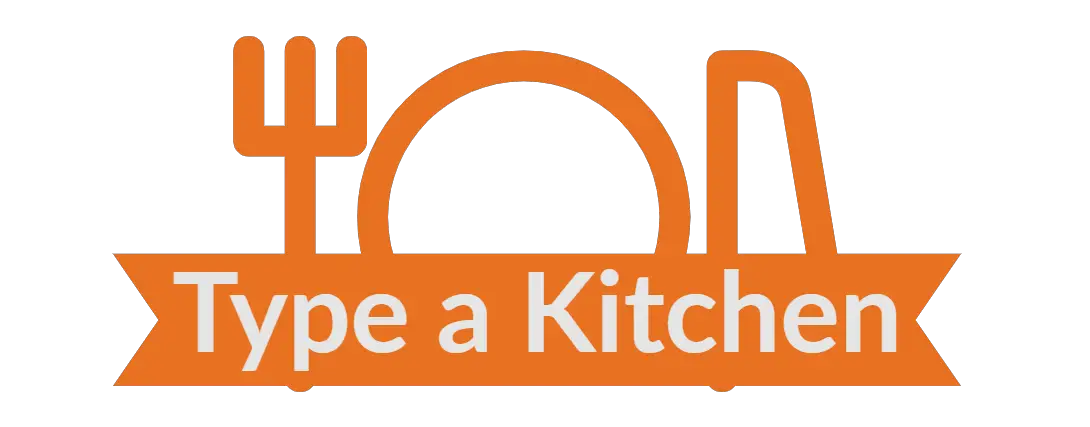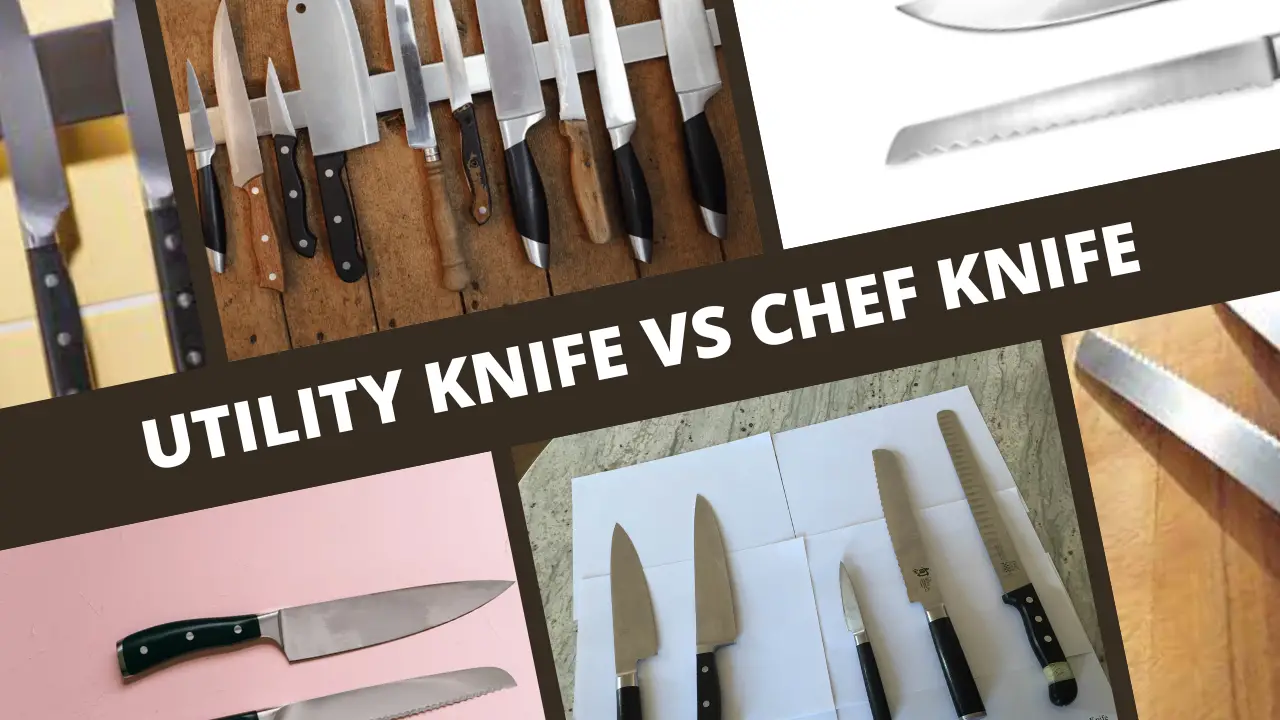A chef knife is a kitchen knife that may be used for a variety of purposes and has a broad blade. It is longer and wider than it is tall, and it has a gentle curvature to its shape.
This design makes it possible to chop, slice, and dice virtually any ingredient ranging from medium to large in size with consistency, speed, and accuracy.
The fact that a utility knife is more compact and shorter than a chef’s knife makes it an excellent tool for making precise cuts.
Utility knives can be used for a variety of cutting tasks, including dicing bread and buns, chopping small fruits and vegetables such as carrots, peppers, apples, etc., mincing garlic, onions, and delicate herbs, and slicing very thin pieces of meat.
Utility Knife vs Chef Knife:
What’s the Difference?
Because it can easily slice through thicker pieces of meat, the chef’s knife is the tool of choice in a commercial kitchen. Because of the precise slices that they produce, these knives are an excellent choice for anyone who needs to simultaneously prepare food for a number of people.
On the other hand, if you are only preparing food for yourself or for a small group of people, then a utility
Additionally, it works wonderfully for chopping small fruits and vegetables, the likes of which would be challenging to do with a chef’s knife.
When you’re cutting bread or anything else that’s crumbly and has the potential to quickly dull your blade, you’ll notice another difference between these two types of knives that come into play.
Because the edge of the chef knife is straight, the material you are attempting to cut will require you to saw in an inefficient manner up and down until you reach the desired point.
What is a Utility knife?
A utility knife has a blade that ranges in length from around 4 to 9 inches and is quite compact and lightweight for its size. As a result, it’s about in between a large chef’s knife and a fruit-paring knife in terms of size. Despite its diminutive stature, it is one of the knives that sees as the most active in the kitchen.
It is perfect for making precise cuts because of its smaller size and shorter length in comparison to a chef’s
Utility knives can be used for a variety of cutting tasks, including dicing bread and buns, chopping small fruits and vegetables such as carrots, peppers, apples, etc., mincing garlic, onions, and delicate herbs, and slicing very thin pieces of meat.
What is Chef Knife?
A chef’s knife is often much longer, with a length that can range anywhere from 6 to 14 inches. Because of its length and width, this design is well-suited for chopping, slicing, and dicing most medium- to large-sized foods. In addition, the blade of a chef’s knife has a subtle curvature to it, which enables the user to do the conventional ‘rocking’ action that is used by professionals.
The user grips the knife and rotates the blade back and forth while squeezing the top for leverage in this one-of-a-kind method of slicing, which enables the user to achieve speed, consistency, and accuracy in their slicing. Obviously, that’s not the end of where the chef’s knife goes.
This tool performs equally effectively regardless of whether you like to chop in a straight up-and-down motion or to mince finely by using the tip of the knife as a pivot point while doing so. In a phrase, its adaptability is extraordinary.
Because the blade is forged from a single piece of metal and extends all the way to the end of the handle, a superb chef’s knife is also incredibly sturdy. This contributes to the knife’s long-term endurance.
Uses of Utility Knife?
Uses for a utility knife include the following:
- Chop up fruits and vegetables such as apples, oranges, bananas, carrots, cucumbers, and peppers on the smaller side.
- Cutting up bread, bagels, English muffins, rolls, and buns, among other baked goods
- You can make your sandwiches and toast taste better by cutting them in half diagonally.
- Slicing meat and poultry into extremely thin slices.
- Chopping up some onions and garlic.
- The process of mincing fragile herbs such as rosemary, thyme, dill, and oregano
Things that are NOT suited for cutting with a utility knife:
- The process of sawing through any type of bone or large piece of meat
- Chopping huge fruits or veggies
- Dividing up food in preparation for serving
- Anything that requires exceptional levels of strength
Uses of A Chef Knife
What kinds of tasks require the use of a chef’s knife:
- The chopping of larger fruits and vegetables such as lettuce, broccoli, cauliflower, celery, cantaloupe, melon, and others.
- Processing huge chunks of meat and poultry by slicing and dicing them.
- Preparing the onions and garlic for chopping
- The process of chopping green herbs such as parsley, cilantro, or basil
- Preparing the meat for cooking by cutting it into smaller pieces.
- Cutting up huge dishes into bite-sized pieces before serving them
Tasks that are Not suitable for the Use of Chef Knife
Things that are NOT appropriate for usage with a chef’s knife:
- The process of slicing through bone or large pieces of meat
- Cutting up bread, bagels, or buns in slices.
- Extremely careful slicing or chopping of the ingredients
- Taking little fruits and vegetables and chopping them.
- Dividing up sandwiches, paninis, or quiches into individual sections
Which One Should You Use?
Utility knives typically feature a blade that is four to six inches long and a handle that is almost the same length. These knives have great balance, and great practicality, and are very easy to use because of the balance that exists between the size of the blade and the size of the handle.
When compared to the slightly bigger chef knife, the utility knife is significantly smaller and lighter overall. As a result of this, it is a very versatile knife that can do both precision and heavier cutting.
You’ll discover that the cutting edge of utility knives is rather straight and extremely sharp. Because this knife
You will end up with a cutting edge that is extremely sharp and durable as a consequence of this. However, it is still pretty brittle, so you need to make sure that you use the knife in the way that it was designed to be used.
The majority of utility knives feature broad handles that are simple and comfortable to use for a variety of cutting jobs. They are nevertheless relatively light and agile, despite the increased circumference that they have.
The handle of a chef knife typically becomes thicker closer to the blade while gradually becoming thinner as it gets closer to the butt, which is the reverse of the handle of a utility knife.
Utility knives are shorter, thinner, and lighter in weight compared to chef knives, which are heavier, bulkier, and thicker.
One of the instruments that every experienced cook will tell you is essential to have in your kitchen. It ought to feel as though an extension of your arm is being used. Chopping and dicing herbs, veggies, and fruit is a breeze with this handy device.
In addition to chopping a wide variety of additional foods, including meat, poultry, and fish. Typically, they are between 8 and 10 inches in length, and the point of the blade is rounded.
Because it is too big to be exact, you shouldn’t use it to peel little vegetables, and you should also avoid using it to carve cooked meat.
So, if you’re simply cooking a meal for yourself or a few people, a utility knife is the better choice as it will do more than just cut through things.
However, if you have a larger family or you’re preparing food at work that requires lots of slicing, chopping, and cutting then having both kinds of knives won’t be such a terrible idea after all. But make sure to buy good quality ones so they last longer!
When do you sharpen the blade of a utility knife?
When you notice that the blade of your utility knife has become dull, you should have it sharpened immediately. The simplest way to know is to examine whether or not your cuts are clean or whether they appear to have been forced. In addition to creating a smooth surface, the blade could also gouge or scratch the material.
When you cut anything in a straight line as opposed to a curved line, the angle at which the blade enters the meal will be different. Try to see how this angle shifts. This will assist you in determining what kind of blade is required for your knife, whether it be for sharpening or replacing the existing one.
How do I sharpen a Utility knife or Chef Knife?
A dull knife is not only unsafe but also serves no purpose. The act of sharpening them breathes new life into them and should be done on a regular basis. How frequently this needs to be done is determined by the
It is more convenient to use an electric knife sharpener, but using a sharpening stone and sharpening steel will give you greater control over what happens to your blade during the sharpening process.
Sharpening With a Whetstone
Using a whetstone to sharpen your kitchen knives is consistently mentioned as one of the most effective methods and for good reason. As you move your knife across the surface of the sharpening stone, the stone will refine and straighten the cutting edge of your blade. This type of sharpening stone comes in the shape of a rectangular block.
To get the most out of your whetstone, make sure to follow the manufacturer’s directions regarding how long it should soak in water before use and how often it should be moistened. Then, while holding your knife at an angle of 20 degrees along the whetstone, drag it softly along each side of the knife a few times.
This will sharpen your knife. If your knife is particularly dull, you should start by using the side of the whetstone that has a coarser grit. You might want to begin with the fine-grade side if it’s only slightly uninteresting. In either case, complete the process of sharpening with the side that is considered finer.
This is a simple device that may restore the sharpness of your dull knife in a hurry. When you use this, start by pressing the blade of the knife onto the coarse side, and then go on to the fine side to complete. This may be a quick answer, but it is not the best option for something that will be used frequently.
These kinds of sharpening tools are not thought to be particularly effective for blades. Therefore, a knife sharpener may work well for you if you possess blades that are not particularly expensive, but you should use a whetstone when you are sharpening knives such as a chef knife, in which you have made a significant financial investment.
Conclusion:
Choosing between a chef’s knife and a utility knife entirely depends on you and what you need to use it for. Utility knives are more affordable and easier to carry around because of their lightweight which makes them perfect for light kitchen work such as slicing fruits, vegetables and boneless meat cuts. On the other hand, if you’re looking for durability and strength then investing in a chef’s knife is definitely worth your money.





